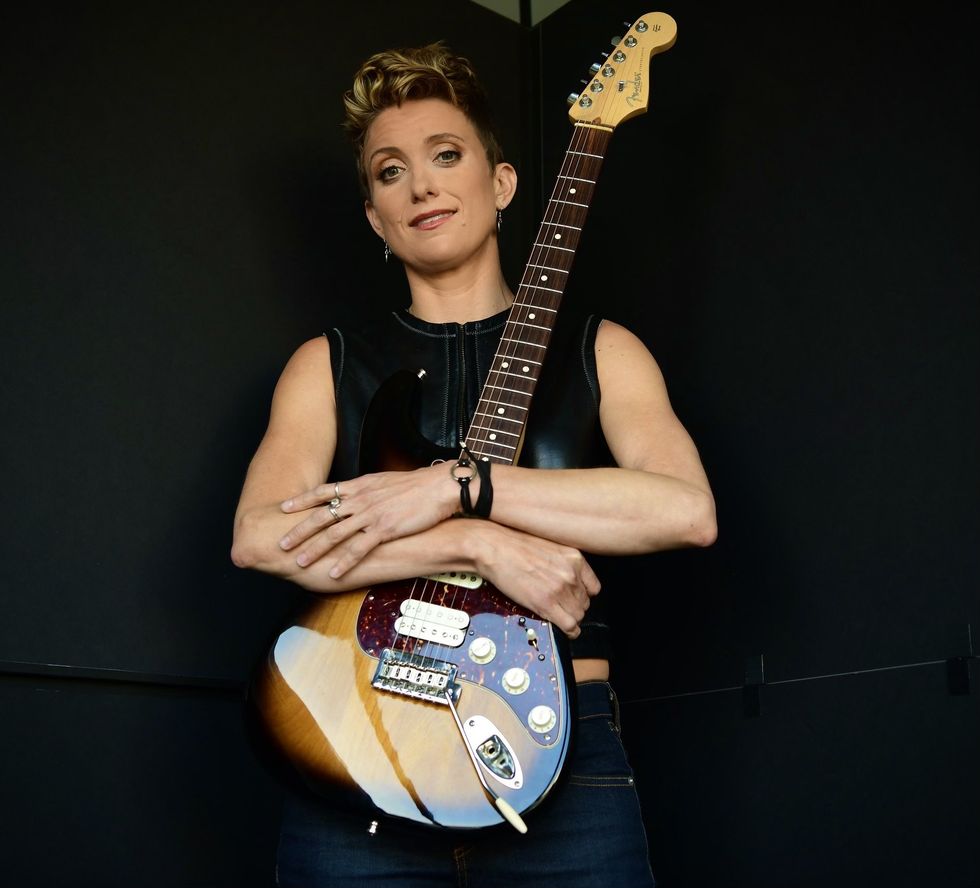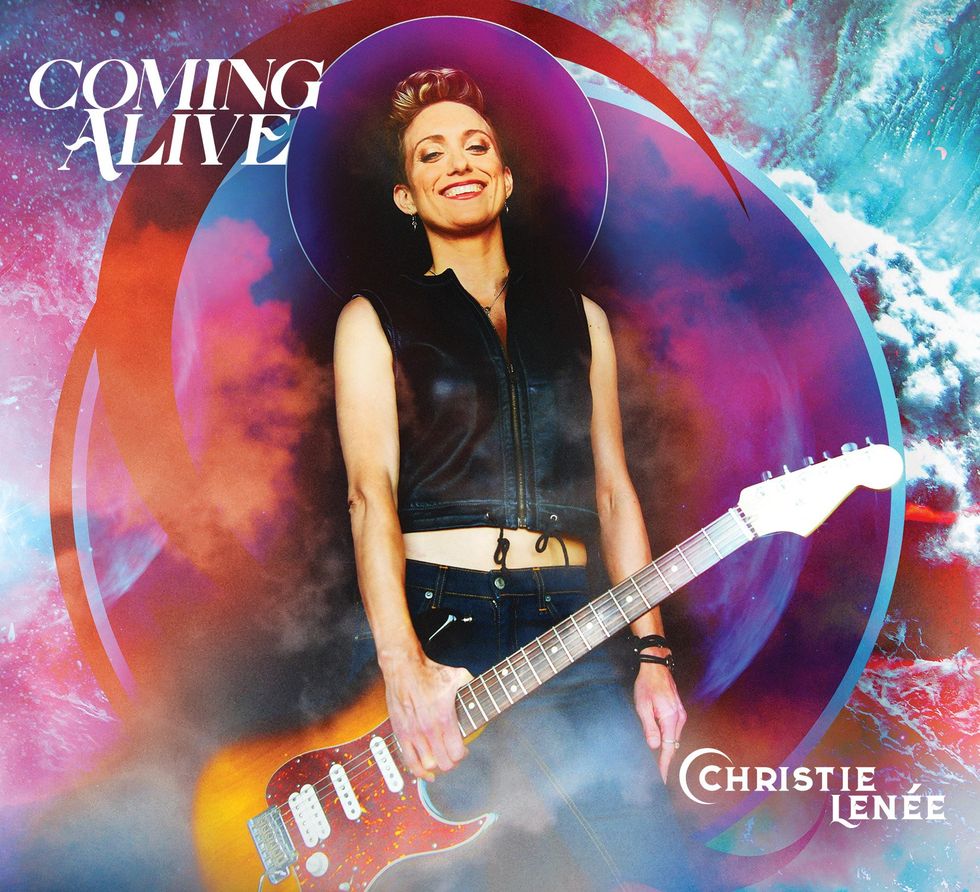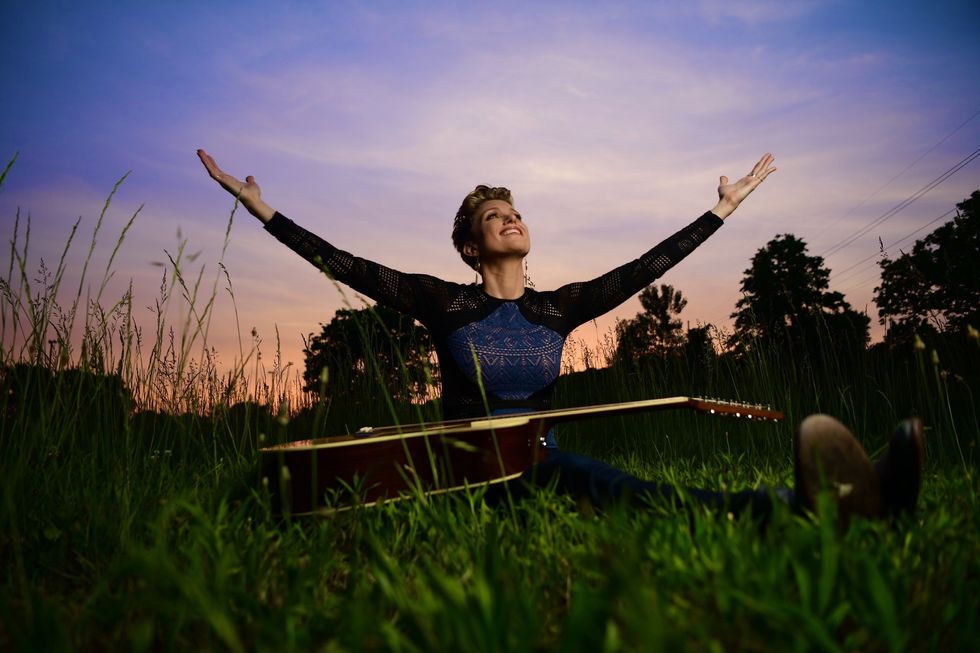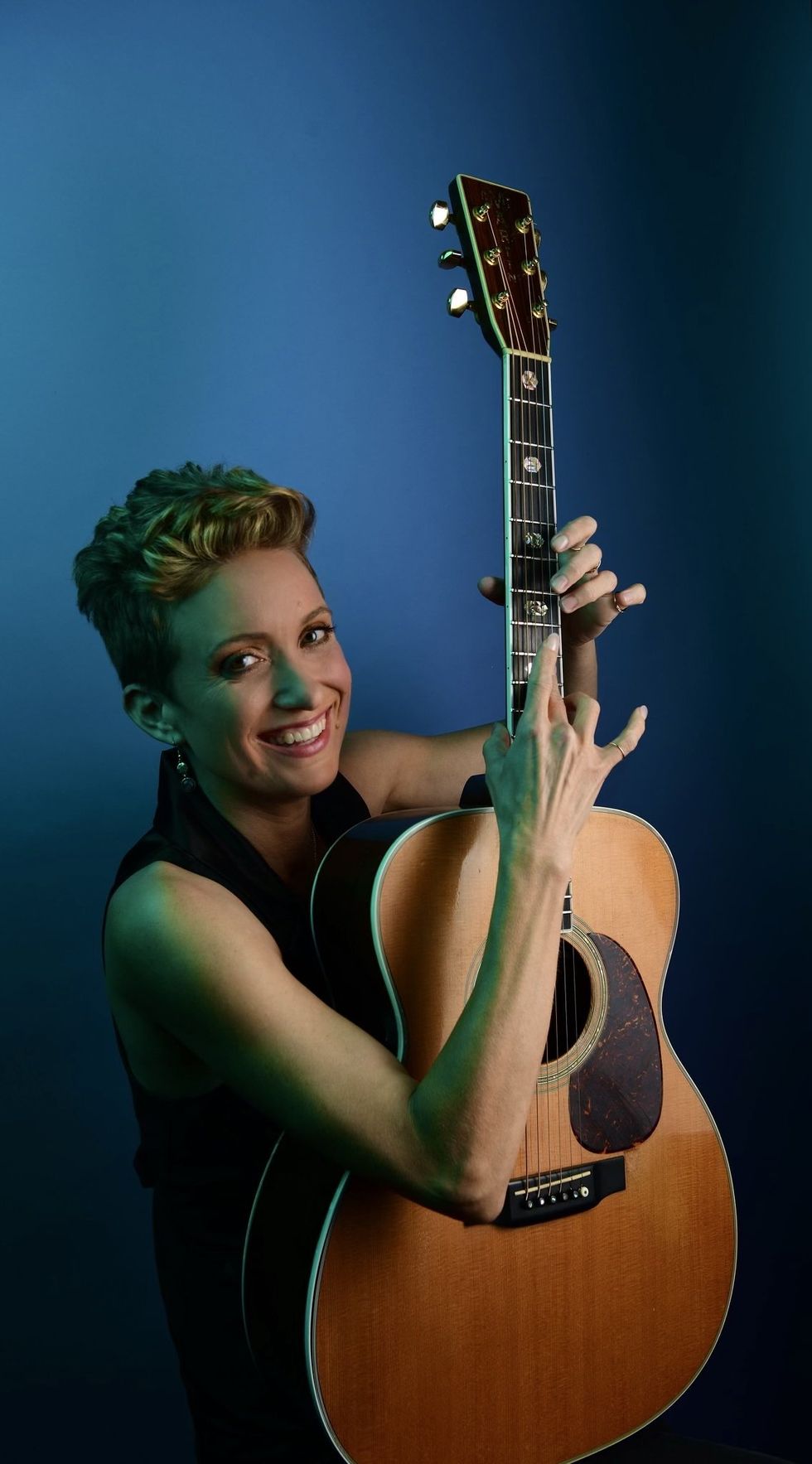During the Covid pandemic, musicians often responded to the crisis by turning inward and scaling down. For example, Matthew Stevens, guitarist for Esperanza Spalding, made the album Pittsburgh on a 1950s Martin 00-17 with no overdubs. Renowned pianist Brad Mehldau, holed up in Amsterdam, offered Suite: April 2020, a collection of short, intimate solo pieces. And Christie Lenée, award-winning fingerstyle acoustic guitarist and singer-songwriter, took stock of her artistic journey in a cabin on Lake Lure, near her home in Asheville, North Carolina. But the results were not what you might expect.
Gradually, the material for Lenée’s latest release, Coming Alive, came into focus. It is the antithesis of a solo guitar album. As some of the most rock-oriented, electric, anthemic music of her career to date, it features esteemed Nashville bassist Adam Nitti and Steely Dan drummer Keith Carlock in the rhythm section, and Charlie Lowell from the Christian alt-rock band Jars of Clay on organ and keyboards. Lenée made a point of posing with her recently acquired Fender Strat for the album cover.
“Around the cabin,” she says, “there was a kind of silence I’d never heard in my entire life—no planes or cars, nothing. At first, I thought I might go a little crazy. I was reflecting on being in this tiny little place in this massive world, and I almost started to speak louder in a way. I’d turn my guitar up, start belting when I sang, play my electronic drum set at all hours. In the woods there’s a frequency I discovered, and my writing and singing changed. My inner voice was able to get a little bit louder. I felt amplified.”
It’s worth noting that Lenée didn’t get louder overnight, nor was this direction purely and simply the result of quarantine. She had ventured into a bigger, poppier, more electric and vocal sound on her 2016 album Stay and farther back on her Give and Take In EP, in contrast to her wholly acoustic 2014 instrumental gem Chasing Infinity. One might call Stay a transitional album, with Lenée rocking out unapologetically on “Journey of My Own,” but reserving space for shimmering acoustic pieces like “Sunset Rebirth” and “Soaring over Glacier Bay.” Give and Take In, similarly, is unafraid to rock but closes with a solo acoustic showstopper, “Evolution”—a fine example of the hybrid-tapping technique Lenée became famously associated with after winning the International Fingerstyle Guitar Championship in 2017. (A tonally brighter take of “Evolution” appears on Chasing Infinity.)

On Coming Alive, Lenée wanted to slightly buck her reputation as an acoustic guitarist by bringing more electric guitar into the mix.
Lenée is, of course, not the first to be recognized for her tapping talents. Michael Hedges and Stanley Jordan, in very different ways, did much to popularize the style in the ’80s. And then, there’s Eddie Van Halen. You can see Lenée’s method in action on “Song for Michael Pukac,” her winning competition entry, where she moves seamlessly between standard fingerstyle and a percussive two-hands approach on the neck, keeping righthand bass notes and patterns going while hammering-on and pulling-off lefthand melodic lines and counterpoint. For good measure, she uses live looping to sustain parts while keeping time with stomp box and foot tambourine.
“I was reflecting on being in this tiny little place in this massive world, and I almost started to speak louder in a way.”
This is still a norm in live solo performance, and Lenée has not abandoned it. It’s a language that lends itself not only to originals like the dreamy waltz “Sterling Highway,” but also interpretive feats like her Beatles medley, which features “While My Guitar Gently Weeps,” “Eleanor Rigby,” and “Yesterday,” all woven together in a rhythmically compelling, story-like whole.
“I was getting to be known as a guitar tapper,” says Lenée, “and I didn’t want to be known completely for that. I want it to be a part of what I do. This album is about taking what I’ve been trying to do on just one guitar and allowing other instruments to play their part, to fully realize the vision that’s in my head. Every song has acoustic guitar except ‘Beautiful Ride’ and ‘Fly Away,’ which are completely electric. I tracked all the guitars like a mad scientist, overdubbing mostly here at home.” Matthew Odmark from Jars of Clay was her main co-producer, although lead vocals were done primarily in Lenée’s hometown of Tampa, Florida, with Spencer Bradham at the board.

In line with the emphasis on electric guitar on Coming Alive, Lenée chose to pose with her Fender Strat on the album cover.
On Coming Alive, however, there is no tapping at all. The arena-rock energy hits right away on the title and opening track, co-produced by session ace (and former Wings guitarist) Laurence Juber. And while acoustic guitar still drives the bus, the album is a meticulously crafted blend, with Lenée playing everything from open-tuned 12-string to her Gretsch White Falcon and that trusty Strat. The sound is poppy and accessible, yet the harmonic and rhythmic involvement of her writing is still present in the 7/4 intro of “Beautiful Ride,” and the frequent meter changes and ethereal chamber-like instrumental bridge of “Another Day Goes By” (featuring Jeff Coffin on soprano sax).
What we get is a full picture of Lenée in all her versatility, playing tasty Strat fills and leads, or keyboard-like chordal pads using the Bigsby arm on her Gretsch. Her acoustics are open-tuned, usually to DADGAD or variants, such as C–G–D–G–B–D (capo on the 4th fret) for “Wildfire” or C–G–D–G–A–D (capo on the 5th fret) for “Beautiful Ride,” or drop D. The key choices are more than incidental: DADGAD, with a capo on the 3rd fret, puts “The Victory We’ve Won” in F, which is “related to the heart chakra,” Lenée says. “It’s a love song and that’s the key of love. I do use my evolving knowledge of sound healing, which looks at what keys are relevant to different moods, and sometimes it’s a part of my process.”

When writing, Lenée considers sound healing and how certain keys are associated with different moods and chakras.
“The Victory We’ve Won” is one of the gentler songs on Coming Alive, incorporating cello and viola (played by Jonathan Yudkin) as well as the mandolin-like soprano Veillette Gryphon 12-string guitar (which Lenée used more prominently on songs from earlier releases “Sweet Little Piece,” “Raining a Miracle,” and “Eastward Horizon”). The song works on two levels: as a paean to the love in Lenée’s life, and as a statement affirming LGBTQ+ equality and dignity. “I am very proud of who I am, and proud of who I love,” Lenée recently told Country Queer. “Being queer informs my emotional experience, which informs my music, and it is all a part of who I am.”
“This album is about taking what I’ve been trying to do on just one guitar and allowing other instruments to play their part, to fully realize the vision that’s in my head.”
Along with her undeniable chops and many talents, what makes Lenée special is her collaborative spirit. If you look back on her catalog, you can treat yourself to her other remarkable compositions, including the hypnotic “Electric Train,” her feature on 2020’s Phil Keaggy & Friends: Instrumental Duets, or the sonorous Keaggy-Lenée single “Peaceful Heart,” not to mention her fun-filled onstage encounters with the great Tommy Emmanuel (“Cleopatra’s Eyes”), or her duos with Laurence Juber (“Calling on the Love”) and Tim Reynolds (“Latin Improv” from Chasing Infinity). On Live at Hideaway Café (2014), we get a feel for Lenée’s full-band show, a real community event, where her acoustic sensibility is in the spotlight (“Daylight Comes”) but her distinguished lead guitar work (“Before I Go”) also has a chance to emerge.
Christie Lenée's Gear

Lenée’s virtuosic tapping skills on acoustic guitar have garnered her major accolades, including the title of International Fingerstyle Guitar champion in 2017.
Guitars
Live
- Maton EM100 808, for “The Messiah”
- Maton Solid Road Series SRS70C-12
- All her Matons are equipped with the AP5 Pro pickup system.
Studio
- Martin D12-35 50th Anniversary 12-string
- Martin J-40
- Martin D-18GE Golden Era
- Gretsch White Falcon
- Fender 2006 American Series Stratocaster
- Soprano Veillette Gryphon 12-string
Amps
- 2000 Fender Deluxe Reverb
Effects
- TC Electronic Polytune Mini
- Seymour Duncan Pickup Booster
- Eventide H9 Max
- Boss DD-20 Giga Delay
- Ibanez Tube Screamer
- Boss RC-30 Dual Track Looper
- TC Helicon Harmony Singer (vocals)
- EBow (on “That Voice”)
Strings, Picks, and Accessories
- Savarez Christie Lenée Signatures (.013–.060)
- D’Addario (electric, .011-.049)
- D’Addario medium (12-string acoustic, .012–.056)
- Dunlop Tortex Standard (.50 mm)
- Acrylic nails: done in salon, filed round on top and underneath, smoothed out with Micro-Mesh 1500 to 12000 grade
- Kyser capos
- Fox 17 Nashville Custom capos
- Maton capos
At this writing, plans were afoot to release a few tracks from Coming Alive without vocals. Clearly Lenée remains committed to exploring that instrumental space wherever she can. But singing is no less central to her authentic self—so much so that her video for “Fly Away” finds her joyously alone, on a beach, with no guitar in sight.
“Recalling that my first instrument is actually voice—just that mental shift completely changed the way I sing.”
“I was so used to the guitar leading everything,” she says, “but I had to learn how to let my voice stand on its own. I was really self-conscious at first, but I pushed past it. My parents divorced when I was 11, and from then until about 17, I didn’t sing much. I put all my feelings into the guitar. But later I realized I was a singer first: I was the youngest member of a group called Entertainment Review in Tampa. I was singing ‘All My Exes Live in Texas’ [by George Strait] at state fairs at the age of 4. Recalling that my first instrument is actually voice—just that mental shift completely changed the way I sing.”
It can take years for an artist to reconcile the many facets of their talent, and when they do, the audience connection grows that much stronger. Acoustic and electric, folk and rock, fingers and pick, playing and singing … rather than dwell on these categories and the boundaries placed between them, Lenée sees the whole continuum and ponders her place in it all, drawing on what feels right and true. “It’s an infinite journey,” she says, “and it’s never perfect. The songs are always changing.”
Christie Lenée and Tommy Emmanuel - "Cleopatra's Eyes" - Dynamic Guitar Duo
Christie Lenée’s collaborative spirit—and playfulness and pure fire–are on display in this duet with fellow acoustic virtuoso Tommy Emmanuel.







![Rig Rundown: AFI [2025]](https://www.premierguitar.com/media-library/youtube.jpg?id=62064741&width=1245&height=700&quality=70&coordinates=0%2C0%2C0%2C0)












 Shop Scott's Rig
Shop Scott's Rig




![Devon Eisenbarger [Katy Perry] Rig Rundown](https://www.premierguitar.com/media-library/youtube.jpg?id=61774583&width=1245&height=700&quality=70&coordinates=0%2C0%2C0%2C0)








 Zach loves his Sovtek Mig 60 head, which he plays through a cab he built himself at a pipe-organ shop in Denver. Every glue joint is lined with thin leather for maximum air tightness, and it’s stocked with Celestion G12M Greenback speakers.
Zach loves his Sovtek Mig 60 head, which he plays through a cab he built himself at a pipe-organ shop in Denver. Every glue joint is lined with thin leather for maximum air tightness, and it’s stocked with Celestion G12M Greenback speakers.













 Luis Munoz makes the catch.
Luis Munoz makes the catch.




























